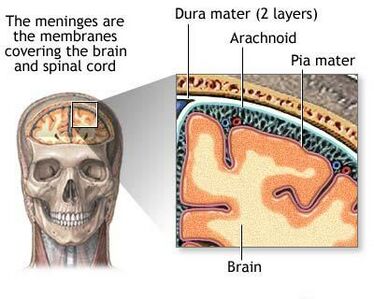Meninges: Difference between revisions
No edit summary |
No edit summary |
||
| Line 10: | Line 10: | ||
* There are three layers from superficial to deep the: dura mater; arachnoid mater; pia mater. | * There are three layers from superficial to deep the: dura mater; arachnoid mater; pia mater. | ||
* Each layer of the meninges serves a vital role in maintenance and function of the central nervous system<ref name=":0">Thought Co Meninges Available:https://www.thoughtco.com/brain-anatomy-meninges-4018883 (accessed 4.5.2022)</ref>. | * Each layer of the meninges serves a vital role in maintenance and function of the central nervous system<ref name=":0">Thought Co Meninges Available:https://www.thoughtco.com/brain-anatomy-meninges-4018883 (accessed 4.5.2022)</ref>. | ||
== Location == | |||
The meninges can be located by anatomical position. | |||
# The portion that surrounds the brain is the cranial meninges. | |||
# The spinal meninges surrounding the spinal cord and the cauda equina. | |||
== Structure == | |||
Both cranial and spinal meninges are broken down into three layers. | |||
# Dura mater: the outermost layer, directly underneath the skull. It is tough, fibrous and inextensible. It consists of two layers, periosteal and meningeal. | |||
# Arachnoid mater: the middle layer, lies directly beneath the dura mater. It is translucent and pliable. | |||
# Pia mater: the innermost layer of the meninges, relatively very thin and fragile. Adherent to the surface of the brain and spinal cord following the gyri (ridges) and sulci (furrows) of the brain’s surface<ref>Geeky medics Meninges Available:https://geekymedics.com/meninges/ (accessed 4.5.2022)</ref>. | |||
== Function == | == Function == | ||
Revision as of 05:33, 4 May 2022
Original Editor - Lucinda hampton
Top Contributors - Lucinda hampton and Rucha Gadgil
Introduction[edit | edit source]
The meninges is a layered unit of membranous connective tissue that covers the brain and spinal cord. They envelope the central nervous system (CNS) structures so that they are not in direct contact with the bones of the spinal column or skull.
- There are three layers from superficial to deep the: dura mater; arachnoid mater; pia mater.
- Each layer of the meninges serves a vital role in maintenance and function of the central nervous system[1].
Location[edit | edit source]
The meninges can be located by anatomical position.
- The portion that surrounds the brain is the cranial meninges.
- The spinal meninges surrounding the spinal cord and the cauda equina.
Structure[edit | edit source]
Both cranial and spinal meninges are broken down into three layers.
- Dura mater: the outermost layer, directly underneath the skull. It is tough, fibrous and inextensible. It consists of two layers, periosteal and meningeal.
- Arachnoid mater: the middle layer, lies directly beneath the dura mater. It is translucent and pliable.
- Pia mater: the innermost layer of the meninges, relatively very thin and fragile. Adherent to the surface of the brain and spinal cord following the gyri (ridges) and sulci (furrows) of the brain’s surface[2].
Function[edit | edit source]
The meninges functions primarily to protect and support the CNS , forming a protective barrier safe guarding the sensitive organs of the CNS against trauma. The meninges
- Deliver blood to CNS tissue via many blood vessels.
- Produces cerebrospinal fluid (CSF), the clear fluid that fills the cavities of the cerebral ventricles and surrounds the brain and spinal cord. CSF protects and nourishes the nervous tissue, acting as a shock absorber, circulating nutrients, and by getting rid of waste products[1].
Sub Heading 3[edit | edit source]
Resources[edit | edit source]
- bulleted list
- x
or
- numbered list
- x
References[edit | edit source]
- ↑ 1.0 1.1 Thought Co Meninges Available:https://www.thoughtco.com/brain-anatomy-meninges-4018883 (accessed 4.5.2022)
- ↑ Geeky medics Meninges Available:https://geekymedics.com/meninges/ (accessed 4.5.2022)







